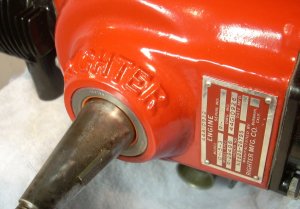
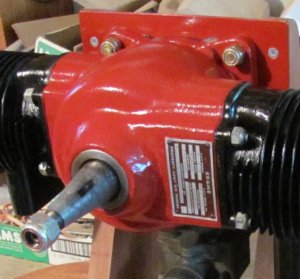
WWII Gunnery Target Engine Technical Analysis
Part 3. The Righter O-15-3 Engine
by Tom Fey
Published 19 Jun 2017
Contents
Part 1. Background and General Configuration
Part 2. The Righter 2-GS-17 (O-15-1) in Detail
Part 3. The Righter O-15-3 Engine
Part 4. Performance and Efficiency Comparison between O-15-1 and O-15-3 Engines
Part 5. The O-45-1 and Kiekhaefer O-45-35
Part 6. Performance and Efficiency Comparison between O-45-1 and O-45-35 Engines
Part 7. Conclusion
The Righter O-15-3 Engine
The US Army did not like having to purchase, stock, and replenish two propellers for each OQ-2 and ultimately test flew an O-15-1 powered OQ-2 using a single, larger diameter propeller on the forward hub. Because launch procedures and operator experience in the perilous takeoff-regime had improved, the drones flew fairly successfully despite the resurgent propeller torque issue at low airspeed. Walter Righter was then tasked with simplifying the O-15-1 engine and raising the horsepower to improve drone performance. The result was the Righter O-15-3 engine that powered the modified, landing gear-less Radioplane OQ-3 (USN TDD-2) aerial gunnery target.
At least 5,822 Radioplane OQ-3 drones were produced in WWII, which outstripped the production capacity of Righter manufacturing. McCulloch Motors of Milwaukee, Wisconsin was subcontracted to build its version of the O-15-3. All Righter O-15-3 engines have "Righter" is raised cast lettering on the nose of the crankcase while the noses on McCulloch engines are without lettering.
 |
 |
| Righter O-15-3, Characterized by "Righter" Cast into the Crankcase Nose. | McCulloch O-15-3. Note absence of cast-in lettering on crankcase nose top. |
Several sources describe the O-15-3 as a 2-GS-17 without the gear case. While generally true, there are significant design differences between the two engines. Instead of describing the similarities to the 2-GS-17, primary focus will be placed on the differences.
The magnesium alloy crankcase of the O-15-3 has the data plate fastened in a vertical orientation below the base of the port cylinder. None of the examined O-15-3 engines has a date of manufacture, and many Righter O-15-3 engines have a data plate bearing no serial number.
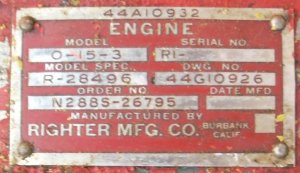 |
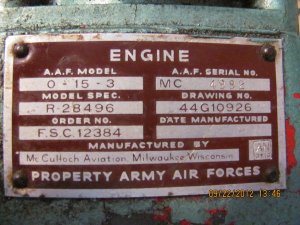 |
 |
| Righter O-15-3 Data Plate. None of the O-15-3 data plates have date of manufacture. | McCulloch O-15-3 Data Plate | O-15-3 Engine Exploded Diagram |
As might be expected, the crankshafts differed in length (8.77" for the O-15-3 versus 15.5" for the 2-GS-17). The untapered crank cheeks of the O-15-3 crankshaft resulted in a crankshaft weight of 62.8 ounces for O-15-3 versus 49 ounces for 2-GS-17. The stroke of 2.125" was the same for the O-15-3 and 2-GS-17, but the diameter of the connecting rod journal was larger for the O-15-3 (1.125" versus 1.000", respectively). The crank cheeks are slabs of uniform 0.40" thickness compared to the tapered thickness (0.3125" maximum thickness) of the cheeks on the 2-GS-17. The front main ball thrust bearing is wider than that on the 2-GS-17 power section.
The connecting rods ends for the O-15-3 have symmetrical big and little end widths, and the crankpins are centered on the cylinder bores.
 |
 |
| Symmetrical O-15-3 Connecting Rod In-Situ During Disassembly. Transfer Port Archway at Top. | Connecting Rod with Bronze Bearing Insert and Cap |
The O-15-3 rotary induction valve is a different design and part number than the valve used on the O-15-1, and is both thicker and heavier (11.6 oz versus 4.1 oz) than the O-15-1 unit. The O-15-3 valve disc relies on a central steel spring washer to maintain disc pressure on the rear case and incorporated cast feet on the back side of the valve that engage the crankshaft webs to drive the valve. The O-15-3 rotary valve has the same diameter and 60° cut out as the O-15-1.
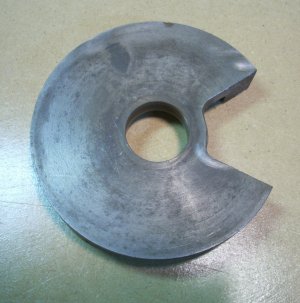 |
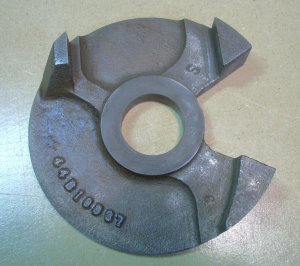 |
| O-15-3 Rotary Valve Induction Face | O-15-3 Rotary Valve Back Side. Note tangs at 1, 4, and 10 o'clock that engage crankshaft web. |
The rear case and timer are identical and interchangeable between the O-15-1 and O-15-3 engines, with the only exception being the condenser that resides inside the timer housing on the O-15-3. The majority of the surviving Righter O-15-3 engines have the manual timer advance, but there is at least one surviving example that has a centrifugal timer.
For the manual timer configuration, a relief is machined into the dowel that is inserted and pinned into the O-15-3 crankshaft tail end. This machined depression allows the points to close, charging the coil, then open as the rubbing block climbs the aft ramp of the depression.
The O-15-3 cylinders have a different part number than O-15-1 cylinders, but they are functionally interchangeable and retain the same bore and stroke as the O-15-1. Rectangular-port, die cast O-15-3 cylinders weigh 37 ounces. The transfer ports and exhaust ports in the O-15-3 cylinder sleeve are slightly larger (0.58" high x 0.484" wide measured on the arc) compared to the O-15-1. While most of the part number 44B10952 cylinders on surviving O-15-3 engines have rectangular ports, there are at least some cylinders that have four round transfer/exhaust ports (0.44" dia on the arc) instead of four rectangular ports. It is unclear whether the round port cylinders were produced by Righter or McCulloch, or exactly when they were introduced in the production life of the engine. The round-port cylinder weighs 2.8 ounces more than the rectangular port version and has 86% smaller port area than the rectangular version. Transfer and exhaust timing are determined by the distance of the top lip of the port to piston top dead center. The top lip of both the round and rectangular ports are at the same height in their respective cylinders, thus the timing of the round port and rectangular port cylinders are identical.
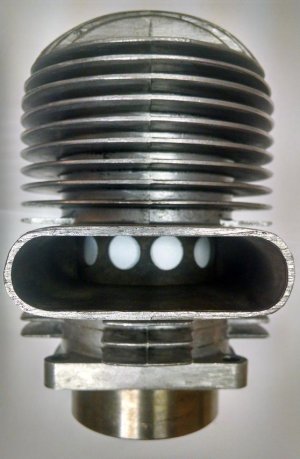 |
| Die Cast, Round Port O-15-3 Cylinder Part #44B10952. Note the smooth surface finish and uniform fin shape produced by die casting. |
The pressure tap for the fuel tank has been relocated to the base of the port cylinder, and there is no ventral crankcase drain plug.
The O-15-3 pistons differ in design and part number from those in the O-15-1, but are interchangeable (in pairs) between the engines. The O-15-3 piston has thinner piston rings (0.085" versus 0.151"), is modestly lighter (6.3 oz. versus 7.1 oz.), and the underside of the piston has three ribs for strength and heat rejection.
The Righter O-15-3 connecting rods are longer (4.375" versus 4.250"), heavier (5.6 oz versus 4.4 oz), and have a big end bore of 1.125" versus 1.000" in the O-15-1. Because of the larger big end bore, the O-15-3 connecting rods are not interchangeable with O-15-1 engine.
The propeller for the O-15-3 is a 30" diameter by 30" pitch, double laminated wood unit that weighs 20.4 oz. with a 2" red tip. The four-bolt propeller hub fits on the 15° crankshaft taper and is the identical part as the fore propeller hub on the O-15-1.
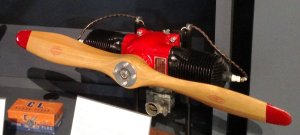 |
| Ritz 30" x 30" Propeller on a Righter O-15-3 Engine |
- On to Part 4. Performance and Efficiency Comparison between O-15-1 and O-15-3 Engines -